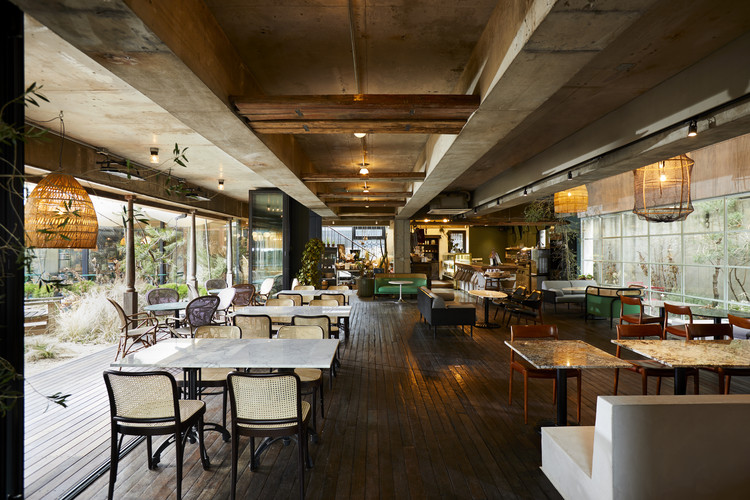Xiashan Primary School STI Studio from the Architectural Design - Research Institute of Zhejiang University
2017-09-10 20:00
Reconstruction of the spiritual home: the design of a resettlement primary school
夏山小学位于浙江省安吉县灵峰地区。这所学校的总土地面积约为20,000㎡。这所学校的建筑面积约为10,000㎡。该学校由18个班级组成,具有相应的辅助功能,即取代现有的临时校舍,并接收父母是重新安置住宅区居民的儿童。由于它靠近主干道,交通拥堵,被广大的安置住宅区所包围,学校周围的环境比较混乱。此外,狭窄的建筑用地导致主建筑的空间非常有限,特别是在安排了所需的室外空间之后。因此,如何在这个狭小的空间中设计出符合儿童特点的功能和空间,可能是建筑师应该考虑的核心问题。
Xiashan Primary School is located in Lingfeng area, Anji County, Zhejiang Province. The total land area of the school is about 20,000㎡. The construction area of the school is about 10,000㎡. The school consists of 18 classes with corresponding supporting functions, which is to replace the existing temporary school buildings and to accept the children whose parents are the residents in resettlement residential area. Because of its near the main road with heavy traffic and be surrounded by extensive resettlement residential area, the environment around the school is relatively messy. Besides, narrow construction land results in very limited space for the main building, especially after arranging the required outdoor space. So how to design a school with function and space conforming to children's characteristics in this narrow space may be a core issues that an architect should consider.
除了家,学校可能是孩子在思想和生活中最可靠的地方。对于父母拆迁安置的孩子来说,离开原来的家园,搬到一个新的陌生社区,对他们来说可能是一件相当有害的事情。这些儿童必须暂时在条件恶劣的过渡学校学习,甚至缺乏辅助场地和其他设施。因此,他们对一所好学校的期望可以成为设计师在他们的创意设计过程中最大的动力。
Except home, school may be the most reliable place for a child both in mind and life. For children whose parents are demolition resettlement residents, it could be a pretty harmful thing on them to leave their original homeland and move them to a new strange community. These children have to study temporarily in a transitional school with poor conditions, even lack of supporting venues and other facilities. So their expectation for a good school can be the greatest motivation for designers in their creative design process.
The construction from "Garden" to "Yard"
在设计阶段之初,我们认为设计是一个宝贵的机会。这将为那些应该在快乐时光度过童年的孩子提供一个美丽的精神“家园”。在我们的设计目标中,我们希望创造一个与外界隔绝的空间,只为儿童的精神归属。这个设计开始于为孩子们建造一个精神上的“家”的想法。我们采用了“围护”和“重组”的方法来组织教学空间和辅助空间,从而形成了院落与空间的结合。封闭的室内庭院不仅是一种丰富的空间体验或视觉体验,也是一个心身私密的世界,一个精神上的“家”,属于儿童。由此,我们的设计完成了从“花园”到“庭院”的设计。
At the beginning of the design phases, we regarded the design as a precious opportunity. Which will provide the children who should have spent their childhood in a happy time a beautiful spiritual “home”. In our design goal, we hoped to create a space that is isolated from the outside world, only for the spiritual ascription of children. The design began with the idea build to a spiritual “home” for children. We used the methods called "enclosure" and "reorganization" to organize the teaching space and auxiliary space, then the combination of yard and space began to take shape. Enclosed inner yard is not only a rich experience of space or visual experience, but also a heart and physical privacy world, a spiritual "home", belong to children. From this our design completed from "garden" to "yard".
Courtesy of Department Of Architecture, Zhejiang University
Environmental integration
建筑用地被群山环绕。如何在建筑中引入自然景观。通过对周边环境的分析和城市设计的研究,设计师借鉴了中国传统园林设计技术。他们在封闭的庭院空间的某些地方打开了框架和视觉走廊,使封闭的露台空间与群山相互呼应,相互联系。在这里,自然景观的传播和山地景观的延伸成为设计的主题。
The construction land is surrounded by mountains. How to introduce natural scenery into architecture. Through the surrounding environment analysis and urban design research, the designers had drew lessons from the traditional Chinese garden design techniques. They opened frame and visual corridor in some places of the enclosed yard space, which made the closed patio space do echo with mountains and contact each other. Here, the communication of the natural sight and the extension of the mountain landscape become the theme of design.
在形成一个相对简单的庭院立面系统的过程中,设计者借鉴了江南景观的概念和太湖石的形象。通过创造不规则的开窗和有趣的立面,使室内庭院的景观水平更加丰富,更好地激发了儿童探索和求知的本能。在这个院子里,设计师创造了精神上的“家”,它融合了儿童的天真和抽象的中国园林意象。
In the process of shaping a relatively simple inner yard facade system, the designers drew on the concept of Jiangnan landscape and the image of Taihu stone. By creating irregular opening windows and interesting facade, they made landscape level of the inner courtyard more abundant, which can better stimulate children's instincts of exploration and seeking knowledge. In this yard, the designers created the Spiritual "home" which incorporates children's naivety and abstract Chinese garden imagery.
An attempt at material and color
在材料和颜色的选择上,考虑到时间、成本、使用、安全等因素,选择了仿白面混凝土涂料作为主要的外墙材料。主色调,华而不实,自然与山色交融。考虑到小学建筑的特点,我们在主要的正面材料中加入了明亮的色彩调制系统,使孩子们感觉更加亲密。这两套色彩系统是互补的,形成了独特的视觉色彩感。
In the selection of material and color, considering the period, cost, use, safety and so on, we chose imitation fair-faced concrete paint as the main facade material. The main color ,cinerous ,blended with the color of the mountains naturally. Considering the characteristics of primary school buildings, we added a bright color modulation system into the main facade material and make children feel more intimate. These two sets of color system are complements, forming a unique visual color feel.
Phased construction planning
由于在以前的土地上建造,该地区分两个阶段实施。原临时教学楼是在2016年4月教学大楼竣工后拆除的,目的是在原土地上修建餐厅、体育大楼和操场配套设施。所有学校的建设预计将于明年三月完成。
As a result of the construction on former land, the area was implemented in two phases. The original temporary teaching building was demolished after the completion of the teaching building in April 2016, in order to build the restaurant , the sports building and supporting facilities of playground on former land. All the school construction is expected to be completed in next March.
在这座建筑中,设计师们把重点放在场地、空间、材料、色彩等方面。他们掌握了孩子们的尺度和心理,然后用建筑的语言来表达人性的思考。通过对精神家园和庭院的追求,设计师提供了一种设计解决方案的方法,并在社会现实的基础上进行了有益的尝试。
In this building, designers focused on the venue, space, material, color, etc. They grasped the children's scale and psychological, then use the language of architecture to express human nature ponder. Through the pursuit of the spiritual home and yard, the designers deliver a way to design solutions and useful try on the basis of the social reality and understanding of children outside the building itself.
 举报
举报
别默默的看了,快登录帮我评论一下吧!:)
注册
登录
更多评论
相关文章
-

描边风设计中,最容易犯的8种问题分析
2018年走过了四分之一,LOGO设计趋势也清晰了LOGO设计
-

描边风设计中,最容易犯的8种问题分析
2018年走过了四分之一,LOGO设计趋势也清晰了LOGO设计
-

描边风设计中,最容易犯的8种问题分析
2018年走过了四分之一,LOGO设计趋势也清晰了LOGO设计

































































































